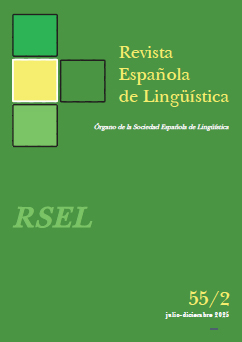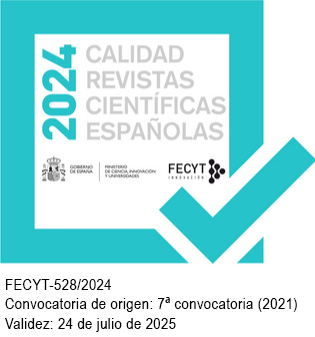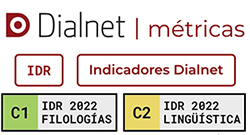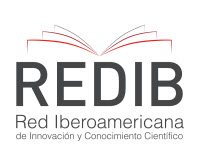Noun Incorporation and Nominal Compounding in Classical Greek: Νομοθέτης as a Case Study
doi: https://doi.org/10.31810/rsel.55.2.4
Keywords:
Noun Incorporation; Compounding; Agent Nouns; Ancient GreekAbstract
In recent years, the impact of Nominal Incorporation in languages has been studied. Ancient Greek is a non-polysynthetic language which, in complex verbs, allows the incorporation of the Direct Object of the base verb as the first element of the compound, thus forming a compound verb whose Direct Object transposes another element of the simple verb of origin. This is the situation that Mithun’s typology establishes as Type II. Now, we propose to study Nominal Incorporation insofar as it affects nominal compounds, especially in agent nouns, and see to what extent it ratifies the proposals that have been given for Greek complex verbs.
Downloads
References
Asraf, N. (2021). The Mechanism of Noun Incorporation in Ancient Greek. Glotta, 97, 36-72.
Ayora, D. (2023). Papeles semánticos y formación de palabras: los sufijos de nombres de agente en griego antiguo [Tesis doctoral, Universidad Complutense de Madrid].
Bailly = Bailly, A., Sechan, L., & Chantraine, P. (20004). Le Grand Bailly. Dictionnaire Grec Français. Hachette.
Baker, M. C. (1998). Incorporation. A Theory of Grammatical Function Changing. Chicago University Press.
Baker, M. C. (20022). Incorporation. In W. Frawley (Ed.), International Encyclopedia of Linguistics (pp. 262-264). OUP.
Baños, J. M., Jiménez López, M. D., Jiménez Martínez, M. I., & Tur, C. (Eds.) (2022). Collocations in Theoretical and Applied Linguistics: From Classical to Romance Languages. Guillermo Escolar Editor.
CGL = Diggle, J. (Ed.) (2021). The Cambridge Greek Lexicon. CUP.
DELG = Chantraine, P. et alii (20092). Dictionnaire étymologique de la langue grecque (Histoire des mots). Klincksieck.
Díaz de Cerio, M. (20222). Sintaxis y semántica del dativo. In M. D. Jiménez López (Coord.), Sintaxis del griego antiguo. Volumen I: Introducción. Sintaxis nominal. Preposiciones. Adverbios y partículas (pp. 297-325). CSIC.
DiCoGrA = Jiménez López, M. D., Baños, J. M. (coords.). DiCoGrA: Diccionario de colocaciones del griego antiguo. https://dicogra.iatext.ulpgc.es [31/07/2025]
EDG = Beekes, R. S. P. (2010). Etymological Dictionary of Greek. Brill.
Haugen, J. D. (2008). Morphology at the Interfaces. Reduplication and Noun Incorporation in Uto-Aztecan. John Benjamins.
Jiménez López, M. D. (2016). On Support Verb Constructions in Ancient Greek. Archivio Glottologico Italiano, 101(2), 180-204.
LSJ = Liddell, H. G., Scott, R., & Jones, H. S. (19799). A Greek-English Lexicon. Clarendom Press.
Luján, E. R. (2025). Advances in Ancient Greek Linguistics. En J. de la Villa et alii (Eds.), Proceedings of the International Conference on Ancient Greek Linguistics. (pp 107-126). De Gruyter Mouton.
Martínez Vázquez, R., Ruiz Yamuza, E., & Fernández Garrido, M. R. (1999). Gramática funcional-cognitiva del griego antiguo I: sintaxis y semántica de la predicación. Universidad de Sevilla.
Meier-Brügger, M. (2000). Indogermanische Sprachwissenscchaft. Walter de Gruyter.
Meier-Brügger, M. (2017). The Lexicon of Greek. In J. Klein, B. Joseph & M. Fritz (Eds.), Handbook of Comparative and Historical Indo-European Linguistics, vol. 1 (pp. 695-710). De Gruyter Mouton.
Mithun, M. (1984). The evolution of noun incorporation. Language, 60.4, 847-894.
Montanari = Montanari, F. (2015). The Brill Dictionary of Ancient Greek. Brill.
Murasugi, K. (2014). Noun incorporation, nonconfigurationality, and polysynthesis. In A. Carnie, Y. Sato & D. Siddiqi (Eds.), The Routledge Handbook of Syntax (pp. 283-303). Routledge.
Pompei, A. (2006). Tracce di incorporazione in greco antico. In P. Cuzzolin & M. Napoli (Eds.), Fonologia e tipologia lessicale nella storia della lingua greca. Atti del VI incontro internazionale di linguistica greca (pp. 216-237). Franco Angoli.
Pompei, A., & Grandi, N. (2012). Complex -éō verbs in Ancient Greek. A case study at the interface between derivation and compounding. Morphology, 22.3, 399-416.
Revuelta, A. (2014). Beneficiary. In G. K. Giannakis (Ed.), Encyclopedia of Ancient Greek Language and Linguistics, vol. 1 (pp. 230-234). Brill.
Riaño, D. (20222). Sintaxis y semántica del genitivo. In M. D. Jiménez López (Coord.), Sintaxis del griego antiguo. Volumen I: Introducción. Sintaxis nominal. Preposiciones. Adverbios y partículas (pp. 251-295). CSIC.
Ricci, E. (2025). Incorporazione del nome in greco antico: il caso di ποιέω ‘fare’ [Sapienza Università di Roma].
Risch, E. (19742). Wortbildung der homerischen Sprache. Walter de Gruyter.
Tribulato, O. (2015). Ancient Greek Verb-Initial Compounds: Their Diachronic Development within the Greek Compound System. De Gruyter.
Published
How to Cite
Issue
Section
Copyright (c) 2025 Revista Española de Lingüística

This work is licensed under a Creative Commons Attribution-NonCommercial-NoDerivatives 4.0 International License.











